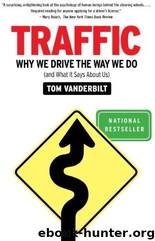Traffic: Why We Drive the Way We Do (And What It Says About Us) by Tom Vanderbilt

Author:Tom Vanderbilt
Language: eng
Format: azw3, mobi, epub
Tags: Science
ISBN: 9780307397737
Publisher: Knopf Canada
Published: 2009-08-11T06:49:44+00:00
How Traffic Explains the World:
On Driving with a Local Accent
“Good Brakes, Good Horn, Good Luck”:
Plunging into the Maelstrom of Delhi Traffic
Opening his eyes, he would know the place by the rhythm of movements in the street long before he caught any characteristic detail.
—Robert Musil, The Man Without Qualities
“What other city in the world is like Delhi?” demanded Qamar Ahmed, the city’s joint commissioner of traffic, as we sat drinking chai in his office. Clad in a khaki uniform topped with bright epaulettes on each shoulder, Ahmed brusquely shifted his attention between me and any one of the three mobile phones on his desk that kept ringing. An air conditioner labored against the enveloping premonsoon heat. “Delhi has forty-eight modes of transport, each struggling to occupy the same space on the carriageway. What other city is like this?”
To exit the Indira Gandhi International Airport, typically at night, when the international flights arrive, and alight into one of the city’s ubiquitous black-and-yellow Ambassador cabs is to enter a motorized maelstrom. As an anticongestion measure, trucks are allowed into Delhi only between ten p.m. and six a.m., and so the sparsely lit road is thronged with lorries. They lurch, belch smoke, and ceaselessly toot their pressure horns. This seems by invitation: The back of most trucks bears the brightly festooned legend “Horn Please,” often accompanied by a request to “Use Dipper at Night” (this means “dim your lights”). “Horn Please” originally invited following drivers to honk if they wanted to pass the slower-moving, lane-hogging trucks on the narrower roads of the past, and I was told that it endures merely as a decorative tradition. Nevertheless, a cacophony of claxons filled the air.
By day, the mayhem is revealed as true chaos. Delhi’s streets play host to a bewildering stream of zigzagging green-and-yellow auto-rickshaws, speeding cabs, weaving bicyclists, slow-moving oxen-drawn carts, multi-passengered motorcycles conveying helmetless children and sari-clad women who struggle to keep their clothing from getting tangled in the chain, and heaving buses, which are often forced out of the bus-only lane because it is filled with cyclists and pedestrians, who are themselves in the lane because there tends to be no sidewalk, or “footpath,” as they say in Delhi. If there is a footpath, it is often occupied by people sleeping, eating, selling, buying, or simply sitting watching the traffic go by. Limbless beggars and young hawkers converge at each intersection, scratching at the windows as drivers study the countdown signals that tell them when the traffic lights will change. Endearingly, if hopelessly, the signals have been embellished with a single word: RELAX. In the roundabouts of New Delhi, the traffic whizzes and weaves defiantly past faded safety signs bearing blunt messages like OBEY TRAFFIC RULES, AVOID BLOOD POOL and DON’T DREAM OTHERWISE YOU’LL SCREAM. These signs are as morbidly whimsical as they are common, leading one to suspect that somewhere, lurking in Delhi’s Public Works Department, is a desk-bound bureaucrat with the soul of a poet.
The most striking feature of Delhi traffic
Download
Traffic: Why We Drive the Way We Do (And What It Says About Us) by Tom Vanderbilt.mobi
Traffic: Why We Drive the Way We Do (And What It Says About Us) by Tom Vanderbilt.epub
This site does not store any files on its server. We only index and link to content provided by other sites. Please contact the content providers to delete copyright contents if any and email us, we'll remove relevant links or contents immediately.
| Buyers' Guides | Classic Cars |
| Customize | Driver's Education |
| Electric & Hybrid | Foreign |
| History | Industry |
| Insurance | Luxury |
| Motorcycles | Pictorial |
| Racing | Repair & Maintenance |
| Trucks & Vans |
Machine Learning at Scale with H2O by Gregory Keys | David Whiting(4260)
Never by Ken Follett(3885)
Urban Outlaw by Magnus Walker(3366)
OPNsense Beginner to Professional by Julio Cesar Bueno de Camargo(3262)
Sapiens and Homo Deus by Yuval Noah Harari(3032)
Will by Will Smith(2874)
A Short History of Nearly Everything by Bryson Bill(2663)
Hooked: A Dark, Contemporary Romance (Never After Series) by Emily McIntire(2527)
Rationality by Steven Pinker(2328)
Borders by unknow(2281)
The Becoming by Nora Roberts(2153)
Holy Bible (NIV) by Zondervan(2101)
HBR's 10 Must Reads 2022 by Harvard Business Review(1822)
A Short History of War by Jeremy Black(1818)
The One Percenter Encyclopedia by Bill Hayes(1811)
Freedom by Sonny Barger(1785)
Go Tell the Bees That I Am Gone by Diana Gabaldon(1732)
Five Ways to Fall by K.A. Tucker(1726)
Girls Auto Clinic Glove Box Guide by Patrice Banks(1709)
